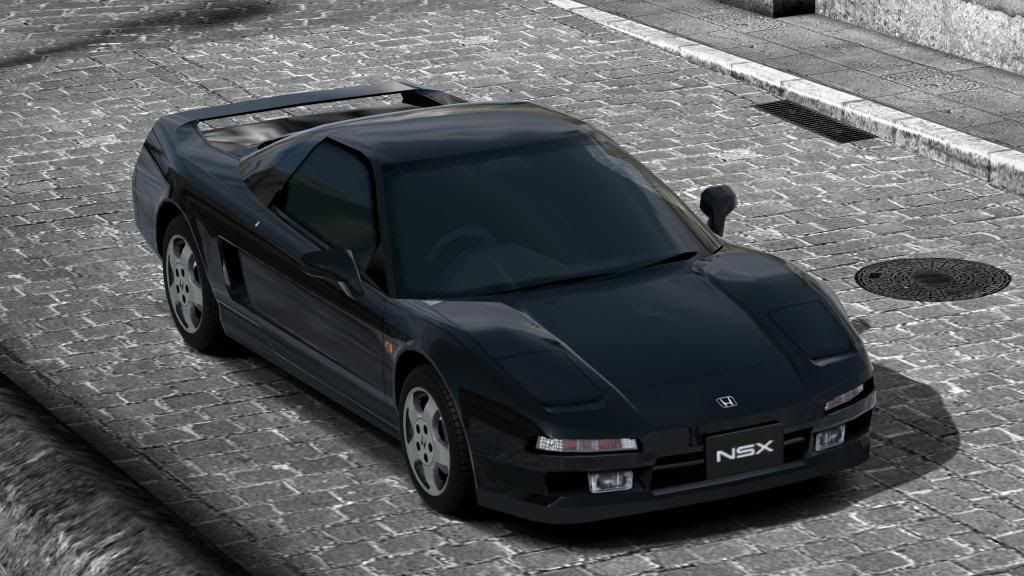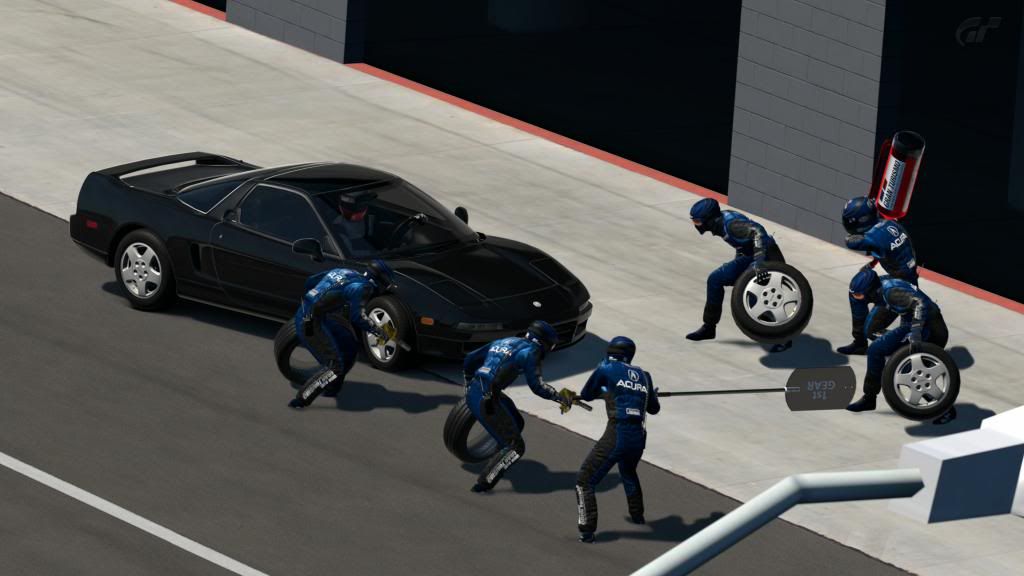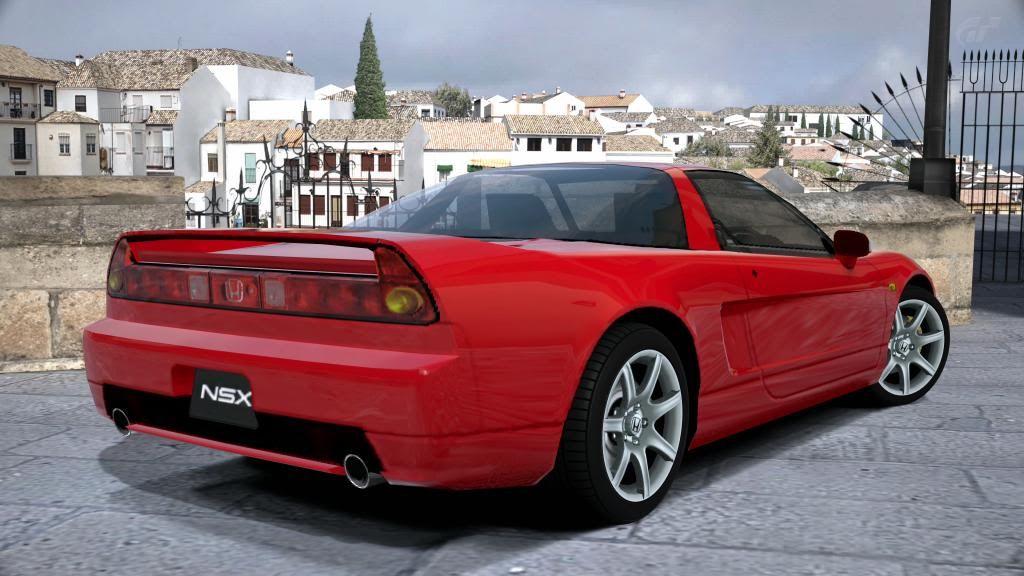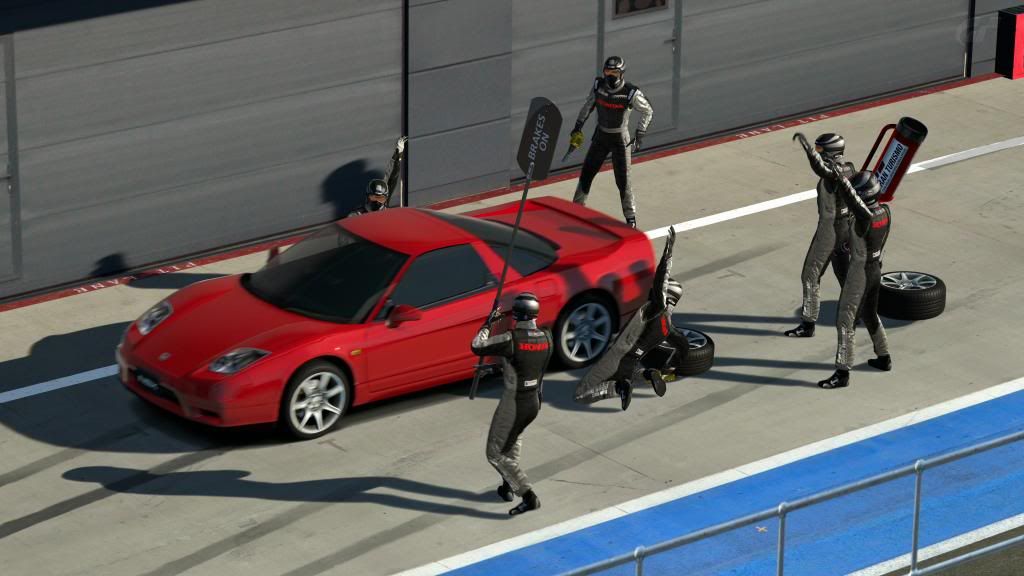"He didn't want to beat me, metaphorically he wanted to destroy me." -Alain Prost
Men don't cry. It isn't that we're incapable of emotion, it's because crying implies weakness, and weakness simply will not be tolerated amongst the pack. Since man's first encounter with a dinner that wasn't first planted, any notion of expressing discomfort amidst hardship is strictly forbidden. Doing so only shows everyone that you aren't as strong as they are, and may very well end up being the one that gets everyone killed. While not exactly as elegant as something written by Hawking or Einstein, the theory does hold some merit. It's not difficult to imagine how successful you'd be sneaking up on a jaguar while sniveling about a broken nail. Instead of hunting dinner, you'd likely find that the roles were reversed, with a giant feline ready to use your soon-to-be corpse as a plaything.
Just because a few millenniums have past doesn't necessarily mean that anything has changed. If anything, evolution has rewarded such behavior, creating Alpha males bent on conquering anything in site just to prove their machismo. At some point someone thought it a good idea that men stop killing each other just for kicks and invented sports, the thought being that a reward would be more satisfying that murdering one's opponent. Today that tradition continues, with over-rewarded Alpha males clashing on various fields, often violently, just to prove their superiority over the male standing next to them. And just like our cave dwelling days, there's still no crying allowed, even in baseball.
Because I'm discussing this topic, I'm bound to appear as being sexist. In today's age of political correctness, it's considered taboo to discuss the differences between the sexes. But facts are facts, and the truth of the matter is that fundamentally there are many differences between the two. While women apply 10,000 different health and beauty products to attract a suitable mate, men just bash whatever happens to be near by with a stick or club. Instead of pondering the aesthetics of matching or contrasting colors and patterns, we use the biggest tools available to erect a structure for those very same colors and patterns, but mostly just for shelter. Despite countless years of progression and evolution, we still play the same illogical games in order to attract a mate, and the different sexes go about this in very different, observable ways.
Much like logic, justice plays absolutely no role in how we go about our business, because society simply doesn't have time for it. For instance, when I was told that we'd be testing our fourth Japanese car in a row, I had every right to bitch, moan and complain. But I can't. Doing so would immediately lead to accusations of being weak, at best, and this column doesn't seem the appropriate place to prove that I do not, in fact, have sand in my vagina. Although I haven't witnessed my best friend's head being blown off on the battlefield or managed to nail my hand to a wall, it is expected of me to carry on in the same manner, unfazed. No matter the hardship or difficulty, showing discomfort proves weakness, and I'm not about to start now.
According to Polyphony Digital (via Translator-san):
"Until Honda introduced the Acura NSX, mid-engine sports cars, while providing an ideal degree of balance and weight distribution, were generally not the most comfortable place to be for both driver and passenger. The emphasis on these cars was usually on all out performance, not luxury. But the NSX was different; it was a world-class performance machine that also incorporated a remarkably high level of ergonomic comfort. it was truly an exotic car that provided enthusiasts the best of all worlds."
"A high-revving, normally aspirated 3.0-liter DOHC V6 was located just aft of the passenger compartment for superior handling balance. This powerplant was the first to incorporate VTEC, the company's revolutionary variable valve-timing technology that was developed from Formula 1 technology. The NSX's aluminum-block V6 produced 276 HP and 216.9 ft-lb, sending the power to the rear wheels via a 5-speed manual gearbox (a 6-speed manual would come later)."
"The chassis was another revolutionary breakthrough for a production car as it was the first road car to feature an all-aluminum monocoque chassis. Sturdy and light, this gave the 1,365 kg NSX incredible agility."
"The NSX's suspension consisted of a double wishbone setup at all four corners, with a new type of bushing called a "compliance pivot" incorporated into the front suspension that maximized ride comfort and offered a higher degree of feedback, making the NSX's on-road responsiveness akin to the day's best race cars."
You might imagine that I'd be overjoyed once I heard that we'd be testing not one, but two NSXs. Surely I'd be happy about moving on past the front-wheel drive shenanigans that I've been moaning about endlessly for the past few months. While a certain part of that may be true, this is by no means easy for several reasons. The first of which is the NSX's reputation to get a little bit tail happy when pushed to the limit, and the last of which are the associations that go with this car. Although we've been at this for quite some time, this is by far the hardest review I've ever had to give, though I shall endeavor to soldier on and do my best. While the performance aspects are difficult, they aren't impossible to manage. It's the history built into the car that provides the biggest obstacle, the only apt comparison being a visit to the Sistine Chapel while critiquing Michelangelo. It isn't difficult appreciating the beauty, but it is quite hard not to get emotional about it.
In 1983 Honda made it's return to Formula 1 with Spirit Racing, after withdrawing from the sport in 1968 with the death of Jo Schlesser, foretold by John Surtees when he labeled it a "deathtrap" earlier in the year. The ridiculous funds spent in motor racing often require some measure of justification, so to showcase the trickle-down relationship between its Formula 1 and road cars, Honda commissioned Pininfarina to design a sports car that would rival Ferrari and Porsche the following year. Much as they had with Spirit Racing in developing their F1 engines, the HP-X concept car was developed with the amount of secrecy that would make Lockheed Martin's Skunk Works look like a public convenience store. Lead by Chief Designer Ken Okuyama and Executive Chief Engineer Shigeru Uehara, Honda allegedly experimented with roughly 20 different layouts and configurations before settling on the mid-engine layout we have today. They also studied monocoque construction materials and assembly, exotic engine materials and principles, all while harnessing the talent they'd acquired in Indycar Champion Bobby Rahal and F1 aces Satoru Nakajima and...
Nope... not going to... Stiff upper lip...
Performance (as purchased): February 21, 2014, Berlina Black (Black) *'93 Honda NSX
Displacement: 2,997 cc
Max. Power: 270 HP @ 7,000 rpm
Max. Torque: 226.9 ft-lb @ 5,500 rpm
Drivetrain: MR
Length: 174.4 in., Height: 46.1 in., Width: 71.3 in., Weight: 1,350 kg
Tires: Sports (Hard)
Performance Points: 446
Mileage: 85.6 mi
Displacement: 2,997 cc
Max. Power: 270 HP @ 7,000 rpm
Max. Torque: 226.9 ft-lb @ 5,500 rpm
Drivetrain: MR
Length: 174.4 in., Height: 46.1 in., Width: 71.3 in., Weight: 1,350 kg
Tires: Sports (Hard)
Performance Points: 446
Mileage: 85.6 mi
The circuit of choice for our test was Honda's test track, the infamous Suzuka Circuit.
Designed in 1962, it's been the home of the Japanese Grand Prix for many
years. Championships have been decided here many times, and it's also
the home of our very own Super Best Friends Super Aguri.
From the HP-X Concept Car to the NS-X prototype, having both the '93
and '01 models here seems appropriate enough. Given the NSX's racing
provenance, it's safe to assume that this car has been around this track
more than the Earth around the sun. As I'm being briefed about the
track, one warning became redundantly clear: we weren't there to break
any records. Of the 155,000 available seats, we'd be filling precisely
zero, so there was absolutely nothing to gain by gambling.
After a quick warm up, I did a hot lap to establish a baseline for performance. On my hot lap, going into the First Curve wasn't a problem, it was the exit that nearly got me, giant plumes of white smoke as evidence of attempted radial homicide. The S Curves were handled a lot easier than I had anticipated, and the nose had absolutely no problems pointing in the right direction. Anti-banked, Denger and Dunlop posed no threat flat out, while 130R required a bit of feathering for a stable entry. 130R ended in yet another puff of smoke, the tyres complacent but very compliant. Given the NSX's reputation for tail happiness, I expected some slide exiting the Hairpin, but with proper throttle application the tyres held up and propelled the car with no sign of drama. Likewise, Spoon is typically tricky, but the NSX stayed mostly flat throughout, shrugging of the challenge and still not sweating. The tail finally slid a little at the exit of the backstretch, but once again the car gave plenty of feedback to know that it wasn't a terminal slide and could be easily corrected. Heaving braking and a twitch at Casio, then a quick jaunt across the start/finish line to the tune of 2:24.702.
After a quick warm up, I did a hot lap to establish a baseline for performance. On my hot lap, going into the First Curve wasn't a problem, it was the exit that nearly got me, giant plumes of white smoke as evidence of attempted radial homicide. The S Curves were handled a lot easier than I had anticipated, and the nose had absolutely no problems pointing in the right direction. Anti-banked, Denger and Dunlop posed no threat flat out, while 130R required a bit of feathering for a stable entry. 130R ended in yet another puff of smoke, the tyres complacent but very compliant. Given the NSX's reputation for tail happiness, I expected some slide exiting the Hairpin, but with proper throttle application the tyres held up and propelled the car with no sign of drama. Likewise, Spoon is typically tricky, but the NSX stayed mostly flat throughout, shrugging of the challenge and still not sweating. The tail finally slid a little at the exit of the backstretch, but once again the car gave plenty of feedback to know that it wasn't a terminal slide and could be easily corrected. Heaving braking and a twitch at Casio, then a quick jaunt across the start/finish line to the tune of 2:24.702.
Although the '93 had a few nervous twitches, it certainly wasn't as "too easy to drive" as Tiff Needell once suggested. Perhaps he hadn't actually found the gas pedal? And don't let those little puffs of smoke fool you, throughout the lap the '93 NSX gave more constant news than an all-day cable news network. If I entered a turn too fast, it'd let me know. Harsh input into or out of a turn? If it wasn't the suspension, steering or chassis keeping me updated, it was the tyres singing a chorus of the damned. Reputation would have you believe that the '93 NSX was nervous, but correct application disproves that by displaying it's responsiveness. It isn't a crackhead going cold turkey, it's more like a sports agent that can actually show you the money. Even though I'm no Formula 1 super star, the time established felt respectable.
After my lap in the black '93, I found it difficult to see how Honda could improve upon an already winning formula. By sourcing Pininfarina early in development, matching the Italians in desireable styling was almost guaranteed. Coupled with Formula 1 and Indycar talent to tackle the handling and suspension characteristics, I find it hard to believe that it could get much better. That's like saying "thanks for turning this water into wine, Jesus, but I think I could do it with a better bouquet." How can you possibly improve the machine when your best testing and measuring equipment isn't around anymore?
No, I promised I... is someone cutting an onion around here?
According to Polyphony Digital (via Translator-san):
"The NSX could well be considered Japan's first mass produced supercar. The car underwent its first significant "minor change" in 1999, and then at the end of 2001 Honda designers decided to dramatically update the NSX's styling. The biggest change they made was to the car's front end, swapping the pop-up headlights for fixed rectangular ones. They also reshaped the front bumper, hood and doors, as well as redesigning the taillights and adding a new bumper skirt. To improve the car's road-holding abilities, the NSX's tire size grew to 215/40R17 up front and 255/40R17 at rear, wrapped around 17-in. forged BBS wheels."
"The suspension was completely retuned to accomodate the new tire sizes, and as a result the NSX's handling prowess improved, making it one of the best-handling cars in the world. Not much later, Honda announced the arrival of the NSX Type R."
"Even after eleven years, the basic qualities of the original NSX remained unchanged. This is a testament to the creators of this elegant performance machine. Sure, the displacement of the engine grew slightly, and there was the addition of a 6-gear manual gearbox, but for the most part, the NSX remained true to its original form and formula, making it one of the most timeless machines to ever come out of Japan."
Soichiro Honda was never one to let the tragedies around him ruin his day. In 1944 he had a plant destroyed by a B-29, the next year another flattened by an earthquake. Despite the ravages of World War II destroying practically everything around him, he could still be found riding his bicycles around town by day and drinking with Geisha by night. Like any man, he didn't cry about his company being reduced to rubble, he sold the salvage and used the proceeds to build generators and engines. Although it took some time, Honda didn't stop working after losing their best talent and close friend, they "put it up to eleven."
Aside from the obvious visual differences between the two, the first big change is noticed the moment you start the engine. Ditching the pop-up headlights in favor of lenses is a giant improvement in the I-have-to-live-with-it sort of way, and nearly every early model Corvette owner will attest, a lot cheaper in the long run. While that same Corvette can be found on the side of the road after 100,000 miles, even the '93 still runs like a Swiss watch twenty years later with absolutely no recalls. While the black '93 NSX sounded like a jaguar locked inside a tiny cage, this one sounds more high strung despite only a hundred extra revs at peak horsepower.
Performance (as purchased): February 21, 2014, New Formula Red (Red) *'01 Honda NSX
Displacement: 3.179 cc
Max. Power: 289 HP @ 7,100 rpm
Max. Torque: 235.4 ft-lb @ 5,500 rpm
Drivetrain: MR
Length: 174.4 in., Height: 46.1 in., Width: 71.3 in., Weight: 1,340 kg
Tires: Sports (Hard)
Performance Points: 457
Mileage: 181.7 mi
In 1997, engineers went mad and started massaging and improving the powerplant, adding even more strength and power. The exhaust was now stronger, lighter, and more efficient, while even more exotic materials like fiber-reinforced metal (FRM) found their way in as well. An extra 182 cc yielded approximately 20 more horses, but the way that those horses were delivered required rethinking even more components. Bigger brakes all around helped reign in the horses, but those too, required increasing the wheels from 15 and 16 in. wheels to 17s. In August of 1998, those modifications were enough to drop the 0-60 mph time by three tenths, at least according to Car and Driver. I typically zone out whenever manufacturers claim that their latest model is "even better than the last", but now I'm honestly intrigued by what the extra horsepower, bigger wheels and brakes, and 10 fewer kilograms are capable of.
I wouldn't have to wait very long. When I returned from my cool-down lap, the Super Best Friends had the red '01 ready to go. Thankfully changes to the interior were minimal, so everything was exactly where it should be, or where I last left it. On my flying lap, I remembered the smoke from exiting the First Curve and prepared for the same sensation fractions of a second before the exit, only this time there wasn't any smoke. The tyres still kept me informed about the available grip left, but the new suspension kept everything planted and pointed in the right direction with even less effort than the '93 before. At the hairpin I found perhaps 10-20 feet of more grip, allowing me to put the power down that much quicker. There were still traces of smoke here and there, but that's only because I was able to carry more momentum through the corners, psychologically rewarding me for pushing harder. When all was said and done, 2:19.899 was on the clock, and almost 5 full seconds were in the bank!
During my cool-down lap and on my way back to the paddock, I had a quiet moment of reflection about what had just happened, the NSX's engine barely audible in the background. I hadn't seen the time yet, but I already knew that this was much faster than the black '93 model, no immediate need to quantify exactly how much, just faster. But... and I know this is odd... I wasn't exactly happy about it. When the NSX was introduced, many Europeans criticized it for lacking character and passion. How they arrived to that conclusion is beyond any measure of reason or logic. Some said it wasn't a supercar because it didn't set out to kill it's driver, but back then that was the typical standard of measurement. Of course, the only people I can think of that believe in losing one's head as a sign of "passion" are the French, and they hardly speak for the whole of Europe.
When I got out of the car, I was greeted by a few Honda representatives as well as Super Aguri, both anxious to hear my first impressions of the cars. Although I had nothing but positive things to say about each, I did my best to decipher and disguise the state of melancholy that appeared within my soul when it was over. Driving the two back to back was like night and day, and during the course of a lifetime, it's only natural to expect improvement and advancement. True enough, the NSX had become more capable, the hard work of it's dedicated craftsmen and technicians had paid off in spades, more than those five seconds are capable in showing in videos or through telemetry. I went faster, so what the hell is wrong with me?!
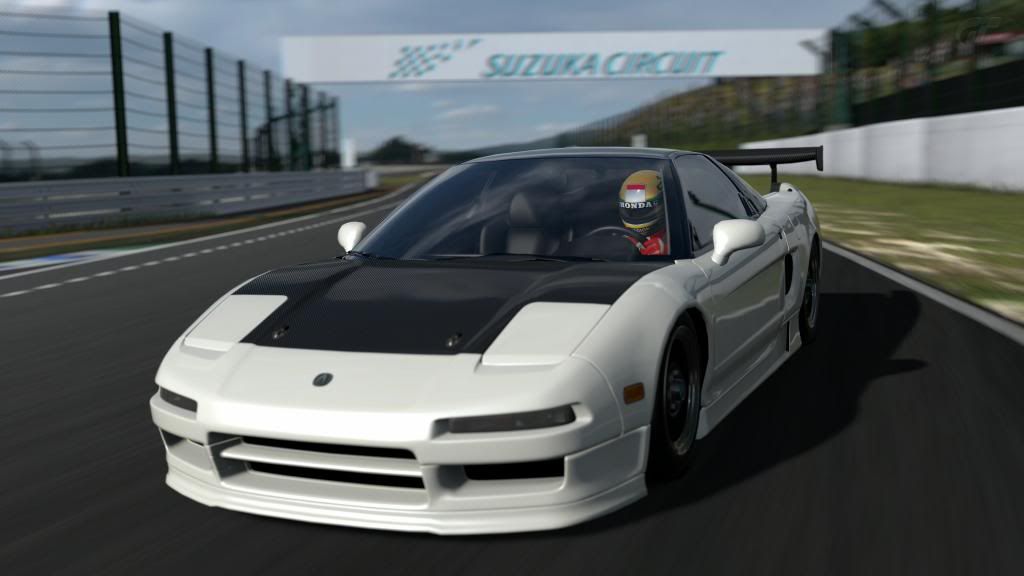
After we left the track the crew went out for sushi and saki while I returned back to the hotel with all of the equipment. Tonight would be the last night of our consecutive run in Japan, and I should be feeling at least 300 different other emotions instead of the state of confusion that I was actually in. I'd been briefed about each by very knowledgeable people beforehand, well aware of the changes between the two. But when it was over, I couldn't quite tell what that change was or if I even liked it. Instead of dreading the return home to whatever drama awaits, I sat by the pool in a nearly comatose state. I'd been hired to test two very similar cars, but suddenly I found that I couldn't really talk about either without returning exactly to my emotional and mental confusion. I went faster, why couldn't I be happy with that?
In that short time... did I change? Was it something I did? Something I didn't do?
At some inappropriate hour during the night, the crew stumbled back to their respective beds, eager to greet the hangovers and layovers that awaited within hours. Meanwhile, I obsessively scoured the video tapes, first watching the hot laps, then every lap in an effort to sort out my head. Although I was expected to convey my impressions to you, I knew then that it'd never be possible if I came home a complete basket case, trapped within my own mind much like Robert Pirsig once found himself. When the in-car footage failed to yield any answers, I soon moved onto the next angle, followed by the next.
A few minutes before dawn, I tore myself away from the viewing screen, and stepped outside to smoke a cigarette. Also outside was the hotel manager, fluent in English as many of the Japanese are. He must've noticed my confusion, striking up a conversation that I'll never forget. I started telling him about driving the black '93, then the red '01 before coming straight back to the problem of what I thought about the whole mess. The Japanese are ardent Formula 1 fans, rivaling the Tifosi in sheer numbers that makes Italy look like local fan club. I've avoided mentioning Senna this entire time, as every NSX conversation eventually leads to him anyway and there's nothing more that I could add that hasn't already been said before. It wasn't until Manager-san mentioned him that things started to make sense.
After I tested the black NSX, I couldn't fathom how Honda could manage to improve it. When the NS-X project began, it was Senna that suggested an improvement in rigidity was vital to its success. Along with Rahal and Nakajima, Senna also gave handling feedback. Therefore, he was equally responsible for the fun that I had as Honda was. Even though it was faster, the '01 felt a but muted, a bit more neutral and conservative than the '93, and I wasn't exactly sure that the numbness would be something that Senna would've signed off on. Sure, I was able to carry more momentum, but the cost turned out to be the hair-raising excitement that was tuned into the '93. Although better in every quantifiable way, the differences between the two were as different as Senna and Rahal, Indycar and Formula 1.
After that conversation, everything was a lot more clear. Despite adding more horsepower, more acceleration, more stopping and more speed, the ultimate sacrifice had been the soul that was originally crafted into it by the feedback of Senna. After the tragic events of Imola, his absence was still being felt, and here it was also on display. The fact that you'll never match the talent of Ayrton shouldn't come as a shock to anyone, but having obtainable access to his soul was just as good. Considering that, the $90,000 original sticker prices hardly seems unreasonable, and it's still only a quarter of what Enzo would've charged you for an inferior car. Although I very much appreciate going faster, sometimes that simply isn't enough.
Which is odd, coming from a man. Factoring in how Senna changed F1 and Honda changed the supercar, expectations have also changed. Convention would have you believe that so-called "pay drivers" lack talent, and that supercars should be jet set performance machines made completely out of unobtanium, styled by Picaso with Pinkeye, then trained to recklessly murder anyone unfortunate enough to shell out the small fortune just to own one. Yet the facts are that Senna was a "pay driver", the NSX proved that supercars can and should be obtainable, useable and safe, and Honda proved that you didn't need to gouge out an eye just to look at one. The NSX also proved that you didn't need the ridiculous neanderthal machismo. There's no need to "man up" when you're already the Alpha, and the combination of Honda, Senna and the NSX wasn't going to replicated. In 2006, there was no NSX.
It has been said that "it takes a big man to admit when he's wrong". So when I tell you that I haven't shed a single tear about the loss of Senna during this review, I lied each time.
*The views and opinions expressed in this review do not necessarily reflect those of the manufacturer, the publisher, GTPlanet.net or it's members, nor anyone with an IQ above 3. If you have a history of epilepsy or seizures, consult a doctor before use. Certain patterns may trigger seizures with no prior history. Underage sale is strictly prohibited. Before using see the instruction manual included with your system for more details. For previous reviews, please visit: McClarenDesign's Very Serious SLS AMG Reviews of the Car of the Week N Stuff. Void where prohibited. All videos were filmed before a live studio audience. Car setup monitored by Dark Lion Racing's GT6 Tunes and Tricks app on Android, as administered by Super Best Friends Super Aguri. Contains wheat and soy ingredients. No goats were harmed in the making of this review that we are aware of. This product may cause significant hair loss, headaches, and damage to the immune system. Best wishes to Michael Schumacher! To advertise, contact McClarenDesign@gmail.com. If not completely satisfied, please return the unused portion for a full refund. If overseas, please include additional postage. Some assembly required.
-Super Previous Super Reviews-
Insightful...
but bollocks: Introduction To Failure (or How I went from a Very
Serious SLS AMG to Super Best Friends Super Aguri)Week 1: '10 Peugeot RCZ
Week 2: '88 Volvo 240 GLT Estate
Week 3: '87 Buick Regal GNX
Week 4: '57 BMW 507 vs '55 Mercedes-Benz 300 SL
Week 5: '72 Alpine A110 1600s vs '72 Alpine A110 1600s (15th Anniversary Edition) vs '73 Alpine A110 1600s
Week 6: '90 Nissan Primera 2.0Te / Infiniti G20
Week 7: '03 Acura CL 3.2 Type-S / Honda Accord Coupe EX
Week 8: '98 Toyota Sprinter Trueno BZ-R / Corolla Levin BZ-R
Week 10: STAY TUNED!

